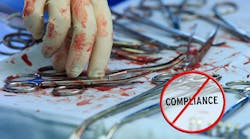Submit your questions: email: [email protected]
Q
I am in clinical operations for the ambulatory sites of a large healthcare system. I have several OB-GYN practices that process their own speculums and instruments. I have encouraged the majority of my 100-plus practices to use disposable instruments or participate in our off-site sterilization program run by our hospitals. Currently they are placing the speculums and instruments in an open container with water in a cabinet until it is convenient to transport them to the lab area for cleaning, disinfecting and sterilization by autoclave. I know that this container must be rigid, with no grooves and a lid clearly marked with the biohazard symbol.
Should the container have a disinfectant soak or is water ok? The soak that we use is expensive and they have many exam rooms in each practice. Also, should there be a biohazard bag inside the container, sprayed with the transport gel instead of liquid? I know their process is not correct and I would like some advice on what the best practice is for handling these instruments to ensure the safety of the patients as well as the staff.
A As you know, disinfection is a distinct function separate from cleaning. To disinfect an item, it needs to be clean and free of all visible and invisible soils. Placing uncleaned items in a disinfectant soak is of course ineffective and a waste of money. It would be more appropriate to utilize an enzymatic spray, gel or soak. The primary goal is to prevent organic matter from drying on the instrument(s). Many have found that placing a moistened towel with water over the instruments in a closed plastic bag is quite effective in preventing organic soils from drying. There are plastic bags color-coded with a biohazard symbol readily available on the market. There is also a special design humidity retention pack commercially available which would work perfectly for your remote clinics. It is a single-use product that consists of a layer of highly absorbent material sandwiched between two layers of a waterproof film. Water is added to the absorbent layer and the soiled item(s) are placed in the bag, which is then secured by a self-seal closure. Once the bag is sealed condensate forms and maintains the soiled contents in a moistened state until cleaning can begin. These bags come in many sizes suited for a few instruments, entire sets, and even endoscopes
Q I read your response to placing the “clean” label over the “biohazard” label on the soiled instrument transport containers. We have several different sized containers with bio-hazard symbols on the lids and base. Would it be necessary to cover all of the biohazard symbols on each container or would one suffice?
AI would suggest that you contact the container manufacturer directly for information on the use of their products and labels. However, in general, I think that your question could best be addressed by your hospital policy. I have always felt that any conflicting symbols or messages on a package are unacceptable, as they may lead to user confusion (e.g., are the contents clean or are they contaminated?). I also think a surveyor might site and/or question this practice. I don’t think it’s necessary to have a symbol on the base of such containers. If items are in the base soaking for disinfection the best practice would be to have the lid on, and likewise, if used to contain soiled or clean items the lid should also be on. In such a case, a label on the lid should suffice and there really would be no need to have the base labeled at all. In my opinion, when the container is in use, to avoid any confusion, any labeling on the base and lid should match.
Q What is the “evidence” that is used for placement of peel packs on their side in a rack? I have someone challenging that if they are placed in a tray, the integrators turn which means the steam sterilized them and they are good to go. I need something in writing that helps me explain that in a tray, just because the integrator changed, that does not mean that the item is completely sterile because in my mind the steam may not have come into complete contact with the entire instrument – especially if it was packed in tight. Please help!
A Refer to AAMI documents and the manufacturer’s instructions for use (IFU). All peel pouch IFUs that I’ve seen state that peel pouches should be placed standing on side or upright in a line formation with paper to plastic. As you know, it is expected that you adhere to IFUs specifically. AAMI standards say the same with the exception to do differently only if the manufacturer’s IFU and documentations state otherwise.
Furthermore, depending on the class of indicator and/or integrator, steam verification does not equate to sterilization. Even a biological indicator doesn’t guarantee a package’s sterility — it confirms the parameters of sterilization were achieved and if all the variables of reprocessing, packaging and loading were satisfied then there is confidence that sterility of a package and its contents were achieved.





